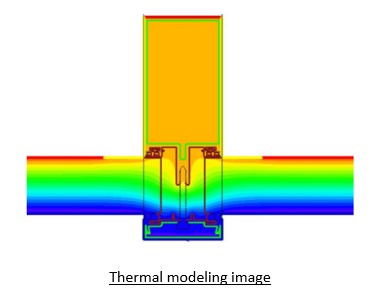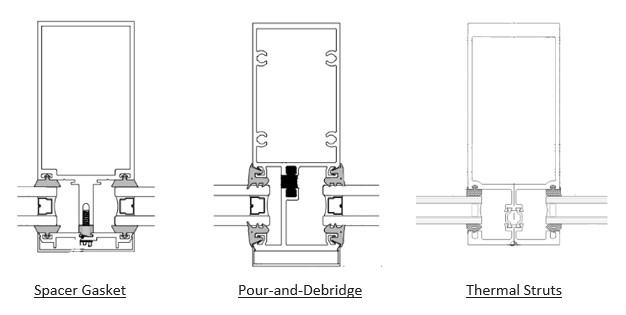The performance of the exterior façade not only depends upon the type of systems, but the ability of the systems to react to environmental conditions. It is the responsibility of glazing contractors to understand how these components work and verify that the systems can meet the specified criteria.
Aluminum systems have advanced over decades to minimize the thermal transmission between exterior and interior. For glazing systems, examples of this criteria combining the glass and aluminum frame specification can be found under PERFORMANCE REQUIREMENTS, as follows.
- Thermal Transmittance (U-factor): Fixed glazing and framing areas shall have U-factor of not more than 0.40, as determined in accordance with NFRC 100.
- Solar Heat Gain Coefficient (SHGC): a. Fixed Glazing and Framing Areas: SHGC for the system of not more than 0.29 as determined in accordance with NFRC 200.
- Condensation Resistance: Fixed glazing and framing areas shall have an NFRC-certified condensation resistance rating of no less than 55 as determined according to NFRC 500.
-
- AAMA 1503.1 – Voluntary Test Method for Thermal Transmittance and Condensation Resistance of Windows, Doors and Glazed Wall Sections.
U-Values measure the insulating performance of the glass and frame, or how much heat/cold flow or heat/cold loss occurs. Thermal breaks separate the interior and exterior pieces and join them with a less conductive material, disrupting the heat/cold transfer between the exterior and interior. The lower the U Value the better the assembly performance.

Solar Heat Gain Coefficient or SHGC measures how much of the sun’s heat comes through the window. The use of thermal breaks can significantly reduce this solar heat gain through the edges of the assembly. SHGC’s can range in value from 0 to 1, with the lower the number the less solar heat the window lets in.
Condensation Resistance or CRF measures how well a product will resist the formation of condensation. Thermally broken aluminum frames help prevent condensation, which occurs with humidity in the air and when the room temperature is different than the interior surface of the aluminum. The higher the number, the better the window will resist forming condensation.
Aluminum is heavily utilized material for its ease of fabrication and infinite recyclability, but it also is a highly thermal conductive material that rapidly transfers energy. Interrupting this transmission or creating a cavity, also known as “thermally breaking” a system, can benefit all aluminum framed fenestration applications.
 Thermally improved systems typically utilize an isolating part or gasket between an exterior cap and the body of the glazing members, such as the case with the typical pressure wall system. Thermally broken systems typically utilize a low conductive polyurethane pour-and-debridged design (such as Azon) or a polyamide plastic thermal strut (such as Insulbar). These structural thermally broken systems are mechanically locked into the metal framing in a process that is intended deter shrinkage and to prevent moisture from passing through.
Thermally improved systems typically utilize an isolating part or gasket between an exterior cap and the body of the glazing members, such as the case with the typical pressure wall system. Thermally broken systems typically utilize a low conductive polyurethane pour-and-debridged design (such as Azon) or a polyamide plastic thermal strut (such as Insulbar). These structural thermally broken systems are mechanically locked into the metal framing in a process that is intended deter shrinkage and to prevent moisture from passing through.
Understanding the purpose and fundamentals of these systems allow for the proper evaluation of applications and their ability to comply with performance requirements.
